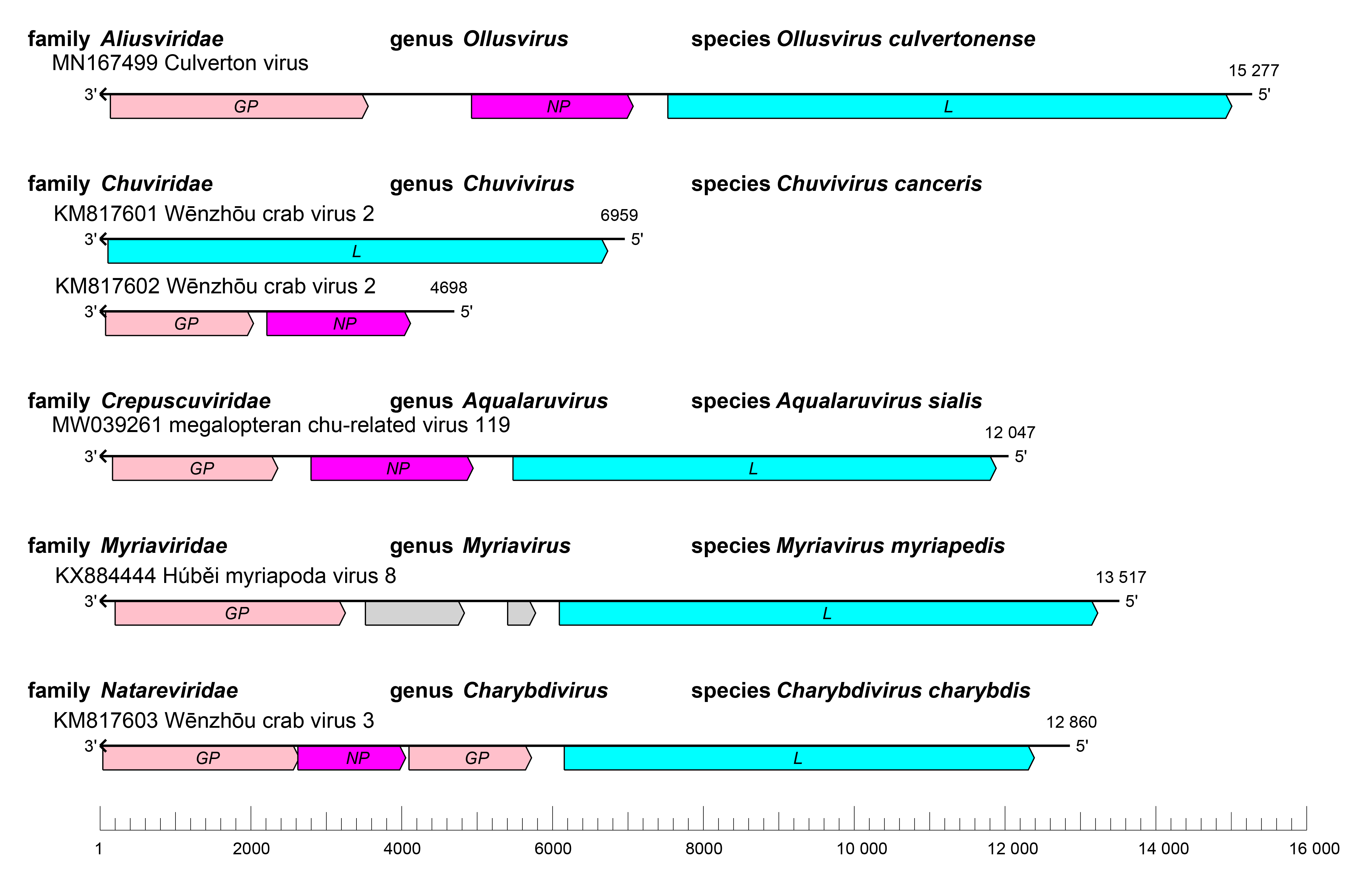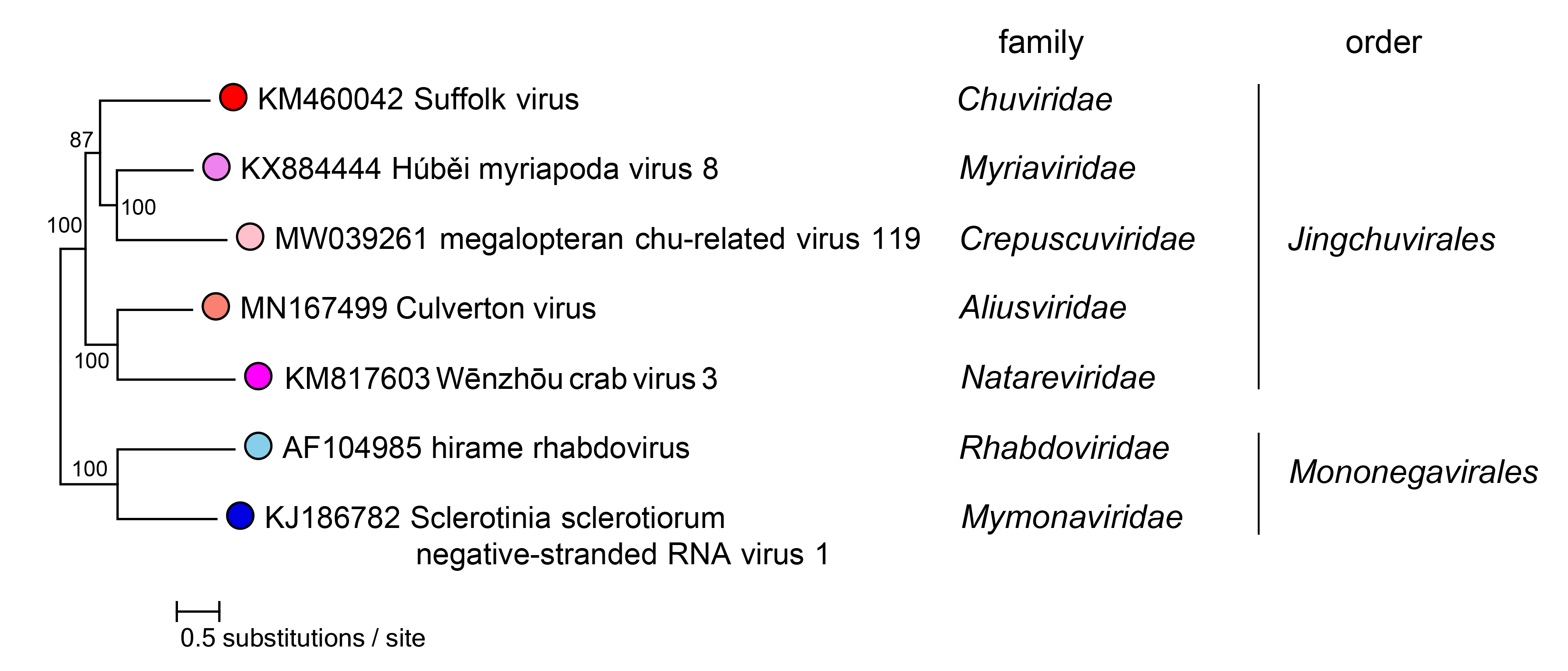Order: Jingchuvirales
Jens H. Kuhn, Nolwenn M. Dheilly, Sandra Junglen, Sofia Paraskevopoulou (Σοφία Παρασκευοπούλου), Mang Shi (施莽) and Nicholas Di Paola
The citation for this ICTV Report chapter is the summary published as:
Corresponding author: Nicholas Di Paola (nicholas.dipaola.civ@health.mil)
Edited by: Jens H. Kuhn and Stuart G. Siddell
Posted: November 2023
Summary
Jingchuvirales is an order of negative-sense RNA viruses with genomes of 9.1–15.3 kb (Table 1.Jingchuvirales) that have been associated with arachnids, barnacles, crustaceans, insects, fish, and reptiles in Africa, Asia, Australia, Europe, North America, and South America. The order includes 5 families, 21 genera, and 58 species for 59 viruses. The jingchuviral genome contains two to four open reading frames (ORFs) that encode a glycoprotein (GP), a nucleoprotein (NP), a large (L) protein containing an RNA-directed RNA polymerase (RdRP) domain, and/or proteins of unknown function.
Table 1.Jingchuvirales Characteristics of members of the order Jingchuvirales
| Characteristic | Description |
| Example | Wēnzhōu crab virus 2 (S1: KM817601; S2;KM817602), species Chuvivirus canceris, genus Chuvivirus, family Chuviridae |
| Virion | Unknown |
| Genome | 9.1–15.3 kb of nonsegmented linear, nonsegmented circular, bisegmented linear or bisegmented circular negative-sense RNA |
| Replication | Unknown |
| Translation | Unknown |
| Host range | Araneaen and ixodidan arachnids; barnacles; decapod and portunid crustaceans; blattodean, coleopteran, dermapteran, dipteran, hemipteran, hymenopteran, megalopteran, odonatan, and siphonapteran insects; myriapods; atheriniform and syngnathiform fish; and squamate reptiles |
| Taxonomy | Realm Riboviria, kingdom Orthornavirae, phylum Negarnaviricota, class Monjiviricetes; the order includes 5 families, 21 genera, and 58 species for 59 viruses |
Virion
Morphology
Unknown.
Nucleic acid
Jingchuvirals have nonsegmented linear, nonsegmented circular, bisegmented linear or bisegmented circular negative-sense RNA genomes with total lengths of 9.1–15.3 kb (Li et al., 2015, Hang et al., 2016, Harvey et al., 2019, Käfer et al., 2019, Argenta et al., 2020, Gondard et al., 2020, Chang et al., 2021, Costa et al., 2023, Schoonvaere et al., 2016, Shi et al., 2016, Sadeghi et al., 2018, Tokarz et al., 2018, Sameroff et al., 2019, Wang et al., 2019, Viljakainen et al., 2020, Wu et al., 2020).
Genome organization and replication
Jingchuvirals have nonsegmented linear, nonsegmented circular, bisegmented linear, or bisegmented circular negative-sense RNA genomes with two to four ORFs that encode a GP, an NP, an L protein containing an RdRP domain, and/or proteins of unknown function (Li et al., 2015, Hang et al., 2016, Harvey et al., 2019, Käfer et al., 2019, Argenta et al., 2020, Gondard et al., 2020, Chang et al., 2021, Costa et al., 2023, Schoonvaere et al., 2016, Shi et al., 2016, Sadeghi et al., 2018, Tokarz et al., 2018, Sameroff et al., 2019, Wang et al., 2019, Viljakainen et al., 2020, Wu et al., 2020). The replication cycle of jingchuvirals remains to be elucidated.
 |
| Figure 1.Jingchuvirales. Genome length, organization, and position of open reading frames (ORFs) of four representative viruses in order Jingchuvirales. ORFs are indicated as boxes, colored according to the predicted protein function. GP, glycoprotein gene; NP; nucleoprotein gene; L, large protein gene. Grey color indicates ORFs encoding proteins of unknown function. |
Biology
Classified jingchuvirals have been associated with araneaen and ixodidan arachnids (spiders and ticks); barnacles; decapod and portunid crustaceans (crabs and shrimp); blattodean (cockroach), coleopteran (glow-worm), dermapteran (earwig), dipteran (louse fly, mosquito), hemipteran (stink bug, water bug, whitefly), hymenopteran (wasp), and odonatan (damselfly/dragonfly) insects; atheriniform and syngnathiform fish; and squamate reptiles (snakes).
In addition, unclassified jingchuvirals have been associated with cephalopods (Rey-Campos et al., 2023), termites (Litov et al., 2022), and turtles (Laovechprasit et al., 2023), and at least one unpublished report suggests that jingchuvirals may infect humans (Quan et al., 2020). Endogenized jingchuviral elements (in particular G-gene-derived nucleic acids) in arthropod genomes indicate that jingchuvirals are millions of years old (Dezordi et al., 2020, Dezordi et al., 2023).
Derivation of names
Aliusviridae: from Latin alius, meaning “other, another”
Chuviridae: from ancient Chinese 楚 (Chǔ) State during the Spring and Autumn Period
Crepuscuviridae: from Latin crepusculum, meaning “twilight, dim”
Jinchuvirales: from Jīngchǔ (荆楚)), which is a synonym for Chǔ (楚), a state in ancient China
Myriaviridae, Myriavirus: from the Greek μύριοι (mýrioi), meaning “myriad”
Natareviridae: from nata, an inflection of the Latin nato, meaning “swim, float”
Family demarcation criteria
Viruses in different jingchuviral families have L protein sequences with <21% amino-acid identity (Di Paola et al., 2022).
Genus demarcation criteria
Viruses in different jingchuviral genera have L protein sequences with <31% amino-acid identity (Di Paola et al., 2022).
Species demarcation criteria
Viruses in different jingchuviral species have L protein sequences with <90% amino-acid identity (Di Paola et al., 2022).
Relationships within the order
Phylogenetic relationships of members of the order Jingchuvirales are shown in Figure 2.Jinchuvirales.
 |
| Figure 2.Jingchuvirales. Phylogenetic relationships of jingchuvirals. Maximum-likelihood tree (midpoint-rooted) inferred by using large protein gene (L) sequences. Sequences were initially aligned by MAFFT version 7 (https://mafft.cbrc.jp/alignment/software/) in Geneious version R9 (http://www.geneious.com) and realigned using ClustalW (https://www.genome.jp/tools-bin/clustalw). The tree was estimated using PhyML 3.0 (http://www.atgc-montpellier.fr/phyml/), a subtree pruning and regrafting (SPR) topology searching algorithm, and a Bayes branch support algorithm. Numbers near nodes on the trees indicate bootstrap values as percentages. Tree branches are scaled to nucleotide substitutions per site (scale bar). |
Relationships with other taxa
The viruses in the order Jingchuvirales are most closely related to sister order Mononegavirales (Di Paola et al., 2022).

